
Page 28: of Maritime Reporter Magazine (October 2011)
Marine Design Annual
Read this page in Pdf, Flash or Html5 edition of October 2011 Maritime Reporter Magazine
THE ARCTICFEATURE By Luis Guarin, Director, Safety Engineering, Safety at Sea Ltd.The IMO?s Sub-Committee on Ship Design and Equipment (DE) is working on a mandatory Code for ships operatingin Polar waters ? widely known as the Polar Code, to supplement other regula- tory instruments, including SOLAS andMARPOL. The Code will seek to address the specific risks relating to operations in Polar waters, taking into account the ex- treme environmental conditions and the remoteness of many locations. The International Association of Antarctica Tour Operators (IAATO), set up in 1991, to advocate and promote safe and environmentally responsible private sector travel to the Antarctic, represents over 100 private sector companies ? the majority of which are passenger ship op-erators. It has expressed its concern that any new rules should properly reflect the diversity of operating conditions in Polar regions. Consequently, it has been work- ing with UK-based Safety at Sea Ltd ona risk assessment - based study of pas-senger vessels operating in Antarctic wa- ters. Dr. Kim Crosbie, environmental operations director of IAATO, said, ?We wanted to take into account all the di- verse elements associated with operating in the Antarctic, including the geography, climate, seasonable variables and the di- versity of the fleet, to evaluate the haz- ards, risks and possible mitigation meth- ods. Our goal is to create a tiered risk ap-proach which could be used in thedevelopment and application of a manda- tory Polar Code.? IAATO has aimed to develop a frame- work for voyage risk assessment which could be used in voyage planning, prepa- ration and execution, and for managing and authorizing activity in line with safety requirements.The organization also wanted to get in- volved in the process because it was con- cerned that the Polar Code could becomeoverly prescriptive using a broad-brush approach. This might have some advan- tages, in being relatively easy to under- stand and implement, for example. However, inflexibility might have an adverse impact on shipping, without any corresponding bene- fits in terms of safety. For example, rules that might appropriately beapplied to vessels operating in the dark winter months or heavy ice conditions might not be as relevant for operations the continuous day-light of summer in ice free waters. Again, a relatively large cruise ves- sel that sails through ice free wa- ters and does not land passengers,faces different safety issues to a small expedition type craft that can land up to 100 persons onshore at atime.COLD COMFORT Luis Guarin, Director of Safetyat Sea, comments: ?Based on theresearch we have carried out to- gether with IAATO, we are now strongly advocating that IMO takes a goal-based and risk-in- formed approach to developing re- quirements under the Polar Code.What we want to avoid is a ?one size fits all? set of rules and regula- tions. The core concept is that the requirements of a Polar Codeshould be based on an understand- ing of the level of risk implicit in particular circumstances.? An initial study carried out bySafety at Sea at IAATO?s request reviewed the current operational activities of IAATO members and created a preliminary risk assessment ofpassenger ship operations in Antarctic waters that could be used in the planning, preparation and execution of a voyage. The process involved defining key prob- lems, identifying potential hazards,analysing risk and assessing various Risk Control Measures (RCMs).The description of the activities of the IAATO members and their operational environment set the scene for the study and involved both an overview of the IAATO fleet and a detailed analysis of a representative vessel. The patterns of tourism were assessed and a representa-tive voyage was identified and used as an example for the risk assessment. In addition seven key environmental and defining features - sea ice cover, sea water temperature, sea conditions, air temperature, traffic levels, Search and Rescue (SAR) response and navigational chart coverage and availability - were evaluated and used to define five repre- sentative sea areas within the Antarctic region. A qualitative risk assessment was undertaken to assess the potential influ- ence of identified factors and hazards on the level of risk. A total of 25 hazards were identified including, for instance, sea ice, unknown bathymetry, and poor surveys. Subsequently, Safety at Sea as- sessed the potential influence of various factors and events on potential risk, specifically in terms of the impact on people, associated with passenger vessel operations in Antarctic waters. The Safety at Sea study concluded that a highrisk to human life was posed by ground- ing, contact with ice and medical emer- gencies; while a moderate risk to life was presented by a vessel becoming stranded in ice, a collision with another vessel and heavy weather damage. The most signif- icant hazards contributing to overall risk were inexperienced crew and poorly maintained vessels. Other significant fac- tors included localised, extreme weather; large seas and swell; and having limited assets available to carry out a rescue. HISTORICAL ANALYSIS The risk analysis carried out by Safetyat Sea used historical casualty data and asample voyage itinerary to assess the fre- quency of incidents and the incidence of The Risk-based Approach to Polar Code 28Maritime Reporter & Engineering News Growing shipping activity in Polar waters, whether driven by tourism, cargo operations or oil exploration has become one of the most significant trends in ship safety over recent years. MR Oct.11 # 4 (25-33):MR Template 10/6/2011 4:19 PM Page 28

 27
27

 29
29
